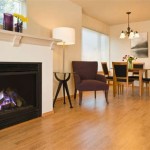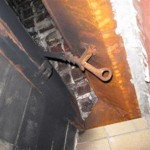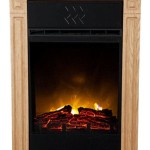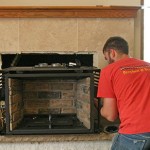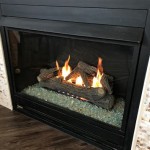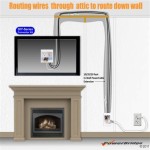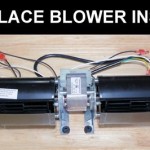```html
Remodeling a Full Wall Brick Fireplace: A Comprehensive Guide
Remodeling a full wall brick fireplace can dramatically transform a living space, breathing new life into a room and increasing property value. This guide provides a comprehensive overview of the process, encompassing planning, preparation, execution, and finishing touches. The scope of the project can range from a simple cosmetic update to a complete structural overhaul, impacting both aesthetics and functionality. Understanding the intricacies of each stage is crucial for a successful remodel.
The initial assessment of the existing fireplace is paramount. This involves a thorough inspection of the brick, mortar, firebox, flue, and surrounding structure. Identifying any structural damage, such as cracks, crumbling mortar, or water damage, is crucial before proceeding with any further plans. A professional chimney sweep can offer a detailed inspection of the flue and firebox, ensuring they meet current safety standards and function efficiently. Any identified issues should be addressed proactively to prevent future problems and ensure the safety of the remodeling project.
Once the initial assessment is complete, the next step involves developing a detailed plan. This plan should encompass the desired aesthetic, budget, and timeline. Researching different design styles, such as modern, rustic, or traditional, can help narrow down the desired look. Consider the existing décor of the room and how the remodeled fireplace will complement it. Gathering inspiration from magazines, online resources, and home improvement stores can aid in visualizing the final outcome. Creating a mood board with preferred colors, materials, and textures can be a valuable tool in communicating the desired aesthetic to contractors or for personal reference.
Budget allocation is a critical aspect of the planning phase. Estimating the cost of materials, labor (if applicable), permits, and potential unforeseen expenses is essential. Obtaining quotes from multiple contractors allows for price comparison and ensures a fair market value is obtained. It's prudent to allocate a buffer for unexpected costs that may arise during the remodeling process. Prioritizing essential elements and making informed decisions about material choices can help keep the project within budget.
Key Point 1: Planning and Preparation
Thorough preparation is the foundation of a successful full wall brick fireplace remodel. This encompasses not only the design and budget aspects but also the physical preparation of the space. Protecting surrounding areas from dust and debris is crucial. This involves covering furniture, flooring, and walls with drop cloths and plastic sheeting. Creating a designated workspace and ensuring adequate ventilation is also essential. If demolition is required, proper safety gear, such as eye protection, gloves, and a dust mask, should be worn at all times.
Demolition, if necessary, should be approached with caution. Removing existing mantels, hearths, or decorative elements requires careful consideration to avoid damaging the underlying brickwork. Utilizing appropriate tools, such as a hammer and chisel, can help remove these elements without causing excessive damage. If the existing brickwork needs to be removed or altered, a professional mason should be consulted to ensure structural integrity is maintained.
Surface preparation is another critical aspect of the preparation phase. Cleaning the brick surface thoroughly removes dirt, soot, and any previous coatings. This can be achieved using a wire brush, a mild detergent solution, and a scrub brush. For more stubborn stains, a specialized brick cleaner may be required. Ensure the brick surface is completely dry before proceeding with any further applications, such as paint, stain, or mortar repair.
When dealing with mortar repair, matching the existing mortar color and texture is essential for a seamless appearance. Mortar matching kits are available at most home improvement stores. Carefully remove any loose or crumbling mortar with a chisel and hammer. Apply new mortar using a trowel, ensuring it is packed tightly into the joints. Smooth the mortar joints with a jointing tool to match the existing finish. Allow the mortar to cure completely before proceeding with any further steps.
Key Point 2: Execution and Material Selection
The execution phase involves bringing the planned design to life. This may involve applying paint, stain, installing new stone or tile veneers, or building a new mantel. The choice of materials plays a significant role in the overall aesthetic and functionality of the remodeled fireplace. Selecting high-quality materials ensures durability and longevity.
Painting a brick fireplace can dramatically alter its appearance. Before painting, apply a primer specifically designed for masonry surfaces. This will help seal the brick and provide a better surface for the paint to adhere to. Choose a paint formulated for high-heat environments if painting the firebox surround. Apply multiple thin coats of paint, allowing each coat to dry completely before applying the next. Consider the overall color scheme of the room and choose a paint color that complements the existing décor.
Staining a brick fireplace can enhance the natural beauty of the brick and add warmth to the room. Choose a stain specifically designed for masonry surfaces. Apply the stain using a brush or rag, following the manufacturer's instructions. Experiment with different application techniques to achieve the desired color and texture. Wipe off any excess stain to prevent a glossy or unnatural appearance. Allow the stain to dry completely before applying a sealant to protect the finish.
Installing stone or tile veneer can completely transform the look of a brick fireplace. This involves applying thin slices of stone or tile to the existing brick surface using mortar. Choose a veneer that complements the desired aesthetic and complements the existing décor. Carefully measure and cut the veneer to fit the fireplace dimensions. Apply mortar to the back of the veneer and press it firmly onto the brick surface. Use spacers to ensure consistent grout lines. Allow the mortar to cure completely before applying grout.
Building a new mantel can add a focal point to the remodeled fireplace. Choose a mantel that is proportional to the size of the fireplace and complements the overall design. A variety of materials can be used for the mantel, including wood, stone, and metal. Ensure the mantel is securely attached to the wall using appropriate fasteners. Consider the placement of the mantel in relation to the firebox and ensure it meets all safety requirements.
Key Point 3: Safety and Code Compliance
Safety and code compliance are paramount throughout the remodeling process. Ensuring the fireplace meets all local building codes and safety standards is crucial for the safety of the occupants and the longevity of the structure. Consult with local building authorities to obtain the necessary permits and understand the relevant regulations.
Maintaining proper clearances around the firebox is essential to prevent fire hazards. Follow the manufacturer's instructions for the fireplace insert or wood-burning stove. Ensure combustible materials, such as furniture and curtains, are kept at a safe distance from the firebox. Install a carbon monoxide detector in the vicinity of the fireplace to alert occupants of any potential carbon monoxide leaks.
Proper ventilation is crucial for the efficient and safe operation of the fireplace. Ensure the flue is properly sized and functioning correctly. A professional chimney sweep can inspect the flue and recommend any necessary repairs or upgrades. Install a chimney cap to prevent rain, snow, and debris from entering the chimney.
Electrical work associated with the fireplace remodel should be performed by a qualified electrician. Ensure all electrical wiring and outlets meet local electrical codes. Ground fault circuit interrupters (GFCIs) should be installed in areas where water may be present. Properly insulate any electrical wiring to prevent fire hazards.
Gas line connections associated with gas fireplaces should be performed by a qualified gas fitter. Ensure all gas lines are properly sealed and leak-tested. Install a gas shut-off valve in an accessible location. Comply with all local gas codes and regulations.
Once the remodeling project is complete, schedule a final inspection with local building authorities to ensure the fireplace meets all code requirements. Address any deficiencies identified during the inspection promptly. Obtain the necessary certificates of occupancy to legalize the remodeled fireplace.
By carefully planning, preparing, executing, and adhering to safety and code compliance, a full wall brick fireplace remodel can be a rewarding project that enhances the beauty and value of a home. Investing time and effort into each stage of the process ensures a successful and long-lasting outcome.
```
11 Brick Fireplace Makeovers My Blessed Life Painted Fireplaces White Remodel

How To Remodel Your Fireplace

I Need Advice For Updating A Very Large Brick Fireplace Wall Hometalk

Diy Brick Fireplace Transformation Makeover

Mortar Wash Brick Fireplace Makeover Dimples And Tangles

Modern Fireplace Makeover House Of Hipsters Home Decor

Brick Fireplace Makeover Before And After House Of Hipsters

Diy Fireplace Facelift Brick Wall Living Room Farmhouse Style Decor Remodel

Diy Brick Fireplace Transformation Hometalk

Fireplace Makeover Process Total Cost In Honor Of Design

